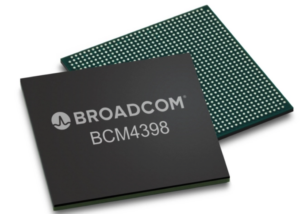Broadcom Inc. has announced the sample availability of its complete end-to-end chipset solutions for the Wi-Fi 7 ecosystem — spanning Wi-Fi routers, residential gateways, enterprise access points, and client devices.
 These Wi-Fi 7 chips more than double the speed of Wi-Fi 6 and 6E solutions on the market today while, simultaneously, delivering reliable low-latency communications and extended range.
These Wi-Fi 7 chips more than double the speed of Wi-Fi 6 and 6E solutions on the market today while, simultaneously, delivering reliable low-latency communications and extended range.
Wi-Fi 7, the most powerful Wi-Fi standard yet, will greatly improve user experience. It doubles Wi-Fi channel bandwidth with the introduction of 320 MHz channels, making it the perfect complement to the expanded worldwide Wi-Fi spectrum in the 6 GHz band. In combination with the upcoming launch of Automatic Frequency Coordination (AFC), Wi-Fi 7 uses optimal spectrum allocation to enable high-power access points and extends the 6 GHz transmit range in indoor and outdoor environments.
Driven in large part by pandemic-driven lifestyle changes, the demand for high performance Wi-Fi continues to grow at unprecedented rates, with 60 percent of consumers upgrading their home Wi-Fi in 2021, and 75 percent planning to purchase additional Wi-Fi devices in 2022. With increased remote work, and growing demand for immersive gaming and streaming, consumers need higher network capacity and stable, deterministic performance.
This makes Wi-Fi 7 an ideal technology for residential customers. 320 MHz channels, together with 4096-QAM modulation, more than double the throughput of Wi-Fi 6E, improve coverage, and keep Wi-Fi performance a step ahead of the broadband speeds that DOCSIS 4.0 and multi-gigabit PON technologies bring to the home. And as emerging augmented reality (AR) and virtual reality (VR) applications drive the next generation of the internet, Wi-Fi 7 sustains high speeds and low latency across a large number of devices.
“Broadcom is once again leading the next generation of Wi-Fi with a full suite of Wi-Fi 7 ecosystem solutions. Our Wi-Fi 7 products and diverse customer partnerships continue the accelerated momentum created by the one billion Wi-Fi 6/6E chips that Broadcom has shipped over the past three years,” said Vijay Nagarajan, VP of marketing for the Wireless Communications and Connectivity Division at Broadcom. “Wi-Fi 7, with its focus on low latency, high reliability, and high speed communications, is the perfect complement to multi-gigabit broadband technologies while enabling the next iteration of the internet and AR/VR devices.”
Enterprise and residential networks will also greatly benefit from the advanced multi-link operation (MLO) capabilities of Wi-Fi 7. MLO, which allows devices to aggregate channels and to rapidly switch between channels, is ideal for high-density and congested networks. MLO allows networks to guarantee commercial-grade quality of service, and enables Wi-Fi as a time-sensitive networking technology for industrial and IoT applications as well. Wi-Fi 7 technology will be critical for delivering fast, reliable video streaming and other applications that require reliable speeds in congested environments.
“Aside from higher data rates, lower latency, and better network capacity, it is Wi-Fi 7’s spectrum flexibility across three bands, its emphasis on the large 6 GHz band, and new techniques like MLO that will greatly improve Wi-Fi’s deterministic performance,” said Phil Solis, research director at IDC. “This is valuable to many different product types and especially to primary devices such as smartphones that have the combination of volume and heavy data usage across a wide variety of applications in both consumer and enterprise settings.”
“We forecast that in five years for both the consumer Wi-Fi infrastructure and in the Enterprise Access Point markets, Wi-Fi 7 revenue will exceed that of any other Wi-Fi technology,” said Chris DePuy, technology analyst at 650 Group. “Wi-Fi 7 takes advantage of the new 6 GHz spectrum. The emergence of 6 GHz is so compelling that we expect well over half of revenues for both the consumer and enterprise markets to come from Wi-Fi systems based on 6 GHz devices.”
Features
Broadcom’s Wi-Fi 7 ecosystem product portfolio includes BCM67263, BCM6726, BCM43740, BCM43720 and BCM4398.
The BCM67263 is optimized for the residential Wi-Fi access point market. Key features include:
- Support for 4 streams of Wi-Fi 7
- Single radio that supports 6 GHz band
- Up to 11.5 Gbps PHY rate
- Up to 320 MHz channel bandwidth
- 4096-QAM modulation
- Multi-link operation (MLO)
- Full compliance to IEEE and WFA Wi-Fi 7 specifications
The BCM6726 is optimized for the residential Wi-Fi access point market. Key features include:
- Support for 4 streams of Wi-Fi 7
- Single radio that supports 2.4 GHz, 5 GHz, or 6 GHz bands
- Up to 5.75 Gbps PHY rate
- Up to 160 MHz channel bandwidth
- 4096-QAM modulation
- Multi-link operation (MLO)
- Full compliance to IEEE and WFA Wi-Fi 7 specifications
The BCM43740 is optimized for the enterprise Wi-Fi access point market. Key features include:
- Support for 4 streams of Wi-Fi 7
- Single radio that supports 2.4 GHz, 5 GHz, or 6 GHz bands
- Up to 11.5 Gbps PHY rate
- Up to 320 MHz channel bandwidth
- 4096-QAM modulation
- Multi-link operation (MLO)
- Full compliance to IEEE and WFA Wi-Fi 7 specifications
The BCM43720 is optimized for the enterprise Wi-Fi access point market. Key features include:
- Support for 2 Streams of Wi-Fi 7
- Single radio dedicated for scanning in the 2.4 GHz, 5 GHz, or 6 GHz bands
- Up to 2.88 Gbps PHY rate
- Up to 160 MHz channel bandwidth
- 4096-QAM modulation
- Multi-link operation (MLO)
- Full compliance to IEEE and WFA Wi-Fi 7 specifications
The BCM4398 is a highly integrated Wi-Fi 7 and Bluetooth 5 combo chip optimized for mobile handset applications. Key features include:
- Support for 2-stream Wi-Fi 7
- 320 MHz channel bandwidth
- 6.05 Gbps PHY rate
- 4096-QAM modulation
- Client multi-link operation (MLO)
- Compliance to IEEE and WFA Wi-Fi 7 standards, as well as Bluetooth Denver standard
Filed Under: Components, News, Wireless

